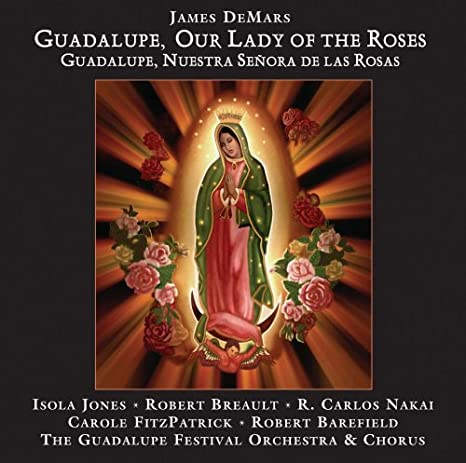James DeMars – Guadalupe, Our Lady of The Roses – Guadalupe, Nuestra Señora de las Rosas (Canyon Records, 2008)
Opera, oratorio and music for mass present a variety of challenges to composers and performers. American composer James DeMars, who is no stranger to Canyon Records or indigenous music has combined structure from opera, oratorio and mass with his opera, Guadalupe, Our Lady Of The Roses. He brings in R. Carlos Nakai (Native American flute) and Xavier Quijas Yxayotl (flutes, whistles of the Aztecs) to represent the indigenous people of Mexico at the time of of the Renaissance and conquistadors in the New World. The opera vocalists, chorus and orchestra represent the Spanish, the Indians, The Virgin of Guadalupe and the Catholic Church.
The brief synopsis reads, “A story of the three apparitions of the Virgin of Guadalupe on the hills of Tepeyac above Tlatelolco in 1531, the appeals of Juan Diego-Cuatlatohuac to the Bishop Zumarraga for a temple at the site of the visions, the revelation of the miraculous portrait and inspiration of peace and trust.” This story might also recall the stories behind the Lady of Fatima and the Lady of Lourdes, among many sightings of the Virgin Mary and miracles associated. This too is a story of miracles, peace and benediction.
For those readers familiar with early music, indigenous music, classical, opera and music of the Catholic Church will most appreciate this complex, spiritual and even enlightening recording. Much of the opera reflects oratorios from the Baroque era in which the vocalists and chorus perform in a recitative style, except for arias sung by Robert Breault (Juan Diego), Isola Jones (Lady of Guadalupe) and Robert Barefield (The Bishop). The narrator sings what appears to be antiphon without a response. Antiphons and polyphony, two proponents of renaissance music of the Catholic Church appear when both the church officials and Diego’s own people turn against him at the end of Act 1 and in Act 2.
The orchestra arrangements provide both dissonance and gorgeous harmonies. The dissonance appears when the Bishop and Diego’s people turn against or make demands on him. I am not an expert in atonal music, but some of the passages reflect Arnold Schoenberg’s work. I have also been listening to Leonard Bernstein’s music for Westside Story lately which reminds me to the extent James DeMars compositions fit into American classical. Similar to Bernstein’s jagged edged jazz-classical in the prologue and The Jets Song in Westside Story, some of the orchestra arrangements possess jagged edges in DeMars work. I was even reminded of George Gershwin’s Porgy and Bess, with some bluesy passages sung by Carole FitzPatrick (La Malinche) towards the end of the opera.
The music for the opera must reflect on religious, spiritual, and indigenous themes as well as, hope, faith and miracles. There is also the test of faith that Diego faces with his own people turning against him and the Bishop attempting to shame him due to his lowly upbringing. Tension contrasts with light and compassion. Certain arias such as It Passes By and Paint For Us Times To Come sung by Jones and the gorgeous Sunrise Song sung by Breault offer door openers to blessings and miracles because no doubt if a listener has been following the libretto closely and finding him or herself fully engaged in the music, a shift in consciousness, even a small one will most likely be the result.
DeMars and all the people involved with this opera deserve a standing ovation, which I am sure they received at the performance which premiered at St. Mark’s Episcopal Church in Mesa, Arizona on May 16 and 17, 2008. Opera works best as a live performance in the right venue with the an alchemical lineup of vocalists and musicians. Listening to this recording on headphones (at a safe volume) is also recommended since it becomes easier to follow the dual languages, the polyphony and the story when heard through headphones.
Hopefully this opera will tour major cities and expose this brilliant bridge between Christians and indigenous peoples as well as, an amazing composition that includes indigenous instruments along with European classical ones. In the same vein that George Gershwin combined jazz and blues elements in his classical work and Aaron Copland included American folkloric music, DeMars brings in American Indian musical elements while creating a work that blurs the lines between oratorio, opera and music for mass.
Canyon Records
Patricia L. Herlevi hosts the healing music blog, The Whole Music Experience. And she has been contributing to World Music Central since 2003, covering jazz, classical and traditional music from around the world.


